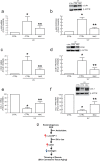Oxidant exposure induces cysteine-rich protein 61 (CCN1) via c-Jun/AP-1 to reduce collagen expression in human dermal fibroblasts
- PMID: 25536346
- PMCID: PMC4275215
- DOI: 10.1371/journal.pone.0115402
Oxidant exposure induces cysteine-rich protein 61 (CCN1) via c-Jun/AP-1 to reduce collagen expression in human dermal fibroblasts
Abstract
Human skin is a primary target of oxidative stress from reactive oxygen species (ROS) generated from both extrinsic and intrinsic sources. Oxidative stress inhibits the production of collagen, the most abundant protein in skin, and thus contributes to connective tissue aging. Here we report that cysteine-rich protein 61 (CCN1), a negative regulator of collagen production, is markedly induced by ROS and mediates loss of type I collagen in human dermal fibroblasts. Conversely, antioxidant N-acetyl-L-cysteine significantly reduced CCN1 expression and prevented ROS-induced loss of type I collagen in both human dermal fibroblasts and human skin in vivo. ROS increased c-Jun, a critical member of transcription factor AP-1 complex, and increased c-Jun binding to the AP-1 site of the CCN1 promoter. Functional blocking of c-Jun significantly reduced CCN1 promoter and gene expression and thus prevented ROS-induced loss of type I collagen. Targeting the c-Jun/CCN1 axis may provide clinical benefit for connective tissue aging in human skin.
Conflict of interest statement
Figures






Similar articles
-
Ultraviolet irradiation induces CYR61/CCN1, a mediator of collagen homeostasis, through activation of transcription factor AP-1 in human skin fibroblasts.J Invest Dermatol. 2010 Jun;130(6):1697-706. doi: 10.1038/jid.2010.29. Epub 2010 Feb 18. J Invest Dermatol. 2010. PMID: 20164845
-
Dermal Fibroblast CCN1 Expression in Mice Recapitulates Human Skin Dermal Aging.J Invest Dermatol. 2021 Apr;141(4S):1007-1016. doi: 10.1016/j.jid.2020.07.019. Epub 2020 Aug 13. J Invest Dermatol. 2021. PMID: 32800875 Free PMC article.
-
Retinoids suppress cysteine-rich protein 61 (CCN1), a negative regulator of collagen homeostasis, in skin equivalent cultures and aged human skin in vivo.Exp Dermatol. 2011 Jul;20(7):572-6. doi: 10.1111/j.1600-0625.2011.01278.x. Epub 2011 Apr 13. Exp Dermatol. 2011. PMID: 21488975 Free PMC article.
-
Cysteine-rich protein 61 (CCN1) mediates replicative senescence-associated aberrant collagen homeostasis in human skin fibroblasts.J Cell Biochem. 2012 Sep;113(9):3011-8. doi: 10.1002/jcb.24179. J Cell Biochem. 2012. PMID: 22566095
-
Antioxidant Properties of Plant-Derived Phenolic Compounds and Their Effect on Skin Fibroblast Cells.Antioxidants (Basel). 2021 May 5;10(5):726. doi: 10.3390/antiox10050726. Antioxidants (Basel). 2021. PMID: 34063059 Free PMC article. Review.
Cited by
-
Human Xylosyltransferase I-An Important Linker between Acute Senescence and Fibrogenesis.Biomedicines. 2023 Feb 4;11(2):460. doi: 10.3390/biomedicines11020460. Biomedicines. 2023. PMID: 36830996 Free PMC article.
-
SOD3 Suppresses the Expression of MMP-1 and Increases the Integrity of Extracellular Matrix in Fibroblasts.Antioxidants (Basel). 2022 May 9;11(5):928. doi: 10.3390/antiox11050928. Antioxidants (Basel). 2022. PMID: 35624792 Free PMC article.
-
Redox Signaling in Diabetic Wound Healing Regulates Extracellular Matrix Deposition.Antioxid Redox Signal. 2017 Oct 20;27(12):823-838. doi: 10.1089/ars.2017.7263. Epub 2017 Aug 10. Antioxid Redox Signal. 2017. PMID: 28699352 Free PMC article. Review.
-
Influence of Redox Stress on Crosstalk between Fibroblasts and Keratinocytes.Biology (Basel). 2021 Dec 16;10(12):1338. doi: 10.3390/biology10121338. Biology (Basel). 2021. PMID: 34943253 Free PMC article.
-
Involvement of Matricellular Proteins in Cellular Senescence: Potential Therapeutic Targets for Age-Related Diseases.Int J Mol Sci. 2024 Jun 15;25(12):6591. doi: 10.3390/ijms25126591. Int J Mol Sci. 2024. PMID: 38928297 Free PMC article. Review.
References
-
- Droge W (2002) Free radicals in the physiological control of cell function. Physiol Rev 82:47–95. - PubMed
-
- Scharffetter-Kochanek K, Brenneisen P, Wenk J, Herrmann G, Ma W, et al. (2000) Photoaging of the skin from phenotype to mechanisms. Exp Gerontol 35:307–316. - PubMed
-
- Yaar M, Gilchrest BA (2007) Photoageing: mechanism, prevention and therapy. Br J Dermatol 157:874–887. - PubMed
Publication types
MeSH terms
Substances
Grants and funding
LinkOut - more resources
Full Text Sources
Other Literature Sources
Miscellaneous

